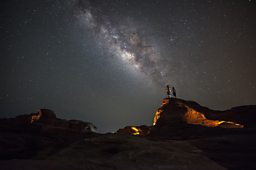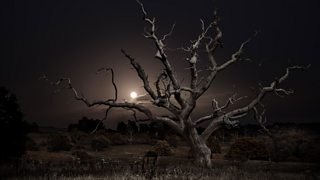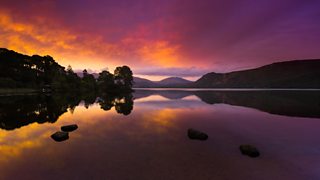Did you know there are three kinds of twilight?

By Βι¶ΉΤΌΕΔ weather presenter Chris Fawkes
Radio 3's Capturing Twilight season presents an opportunity to explore exactly what this evening and early morning phenomenon is.
Twilight can gift us some of the most spectacular atmospheric displays, a riot of shifting colours that punctuate the end of a day, or announce the arrival of a new morning.
The palate and quality of shadowless light has inspired artists, composers and authors from time immemorial and can induce feelings of awe, but also serenity.
These dazzling displays are brought to us thanks to the conjunction of the Earth's orbital and atmospheric characteristics.
Twilight is the time, at the end of a day, between the sun setting below the local horizon and before the beginning of the night.
It is also the time between the end of the night and the sun rising above the local horizon, that marks the beginning of a new day.
From a meteorological perspective, twilight is further subdivided into three categories: Civil twilight, Nautical twilight and Astronomical twilight. These are based on how far the sun is beneath the horizon, with light and colour draining from the skies as night approaches.
Civil twilight

Civil twilight gives us the most vibrant, colourful skies. This is the time between sunset and when the sun is 6 degrees below the horizon. The fact that twilight exists at all on Earth is due to the light-bending properties of our atmosphere. The sun's light is still travelling through higher parts of the atmosphere following sunset or prior to sunrise. The atoms and molecules in the upper atmosphere refract or bend the light sending us ample light to still see clearly.
The fact that twilight exists at all on Earth is due to the light-bending properties of our atmosphere.
The redder colours of light are produced by the preferential scattering of short wavelength blue light by air molecules, leaving a greater proportion of longer wavelength red light.
The most spectacular sunset displays occur when this red light travels through an airmass that has low levels of pollution or dust, but also has some patches of medium and high cloud to bounce the red light off. This is the time that the brighter stars and planets such as Venus, become visible to the naked eye.

Twilight for many people may feel like a constant transition separating day from night, and night from day. But in fact, the length of twilight varies by latitude – this effect is very pronounced even here in the UK! In London, civil twilight can last up to 48 minutes.
Whereas in Shetland around the summer solstice the sun never drops more than 6 degrees below the horizon, therefore Civil twilight stretches for nearly 5 hours from sunset to sunrise the next day – it never properly goes dark!
Thanks to the Earth's 23.5 degree tilted axis, the length of twilight also varies with the seasons.
Nautical twilight

Colour and light begin to drain away through Nautical twilight, when the sun is between 6 and 12 degrees below the horizon. In this low light environment our eyes switch to use rod rather than cone photoreceptors; as a result, we tend to see more in greyscale rather than colour. The discernible detail washes away from distant objects as our eyes struggle to keep the encroaching blackness at bay. More stars become visible. If you're lucky, you may be able to see ephemeral Noctilucent clouds, the Earth's highest cloud, glittering across the skies 50 miles above ground!
Astronomical twilight

Astronomical twilight is the transition to fully dark skies, when the sun is between 12 and 18 degrees below the horizon.

Fainter stars and galaxies come out to play and auroras can been seen dancing, rippling and weaving across the heavens. Beyond astronomical twilight, dark night skies lurk.
Some of the most vivid and colourful twilights have been observed following very large volcanic eruptions. Probably the most famous of these events followed the eruption of Krakatoa in May 1883.
This huge eruption blasted very large quantities of ash and sulphur dioxide into the Earth's stratosphere. These particles spread around the globe via the jet streams, creating brilliant multicoloured afterglows in many locations, including London.
Some have suggested the skies in Edvard Munch's most famous masterpiece, "The Scream", painted ten years later in 1893, were inspired by the Krakatoa generated afterglow during twilight.
It's not surprising that we find inspiration in the myriad colours and ever-shifting nature of twilight.
Even as a backdrop of the most familiar of vistas, twilight has the power to surprise and delight in equal measure.
Photos © Getty Images

Capturing Twilight programmes on Radio 3
-
![]()
Words and Music: Twilight
The dimming of the day reflected in works by Adrienne Rich, James Joyce and Peter Porter, read by Clare Perkins and Neil Pearson, with music by Wagner, Sally Beamish and The Fall.
-
![]()
Between the Ears: Capturing Light
Printmaker Norman Ackroyd leaves on a boat at dawn to paint the sunrise on Suffolk's crumbling cliffs from the North Sea for the first time, with a new poem by Nancy Campbell.
-
![]()
In Tune: Live from Armagh, Northern Ireland
Sean Rafferty discovers more about the many different types of twilight as he visits the Armagh Observatory and Planetarium.
-
![]()
Capturing Twilight: Sarah Walker with a brightly lit musical mix
Sarah Walker plays an uplifting selection of music to make the most of the lightest time of the day during the darker months.




